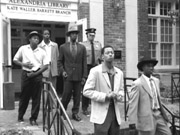






|
Out of Obscurity In 1939, just before World War II broke out, five young men staged a civil protest to open the Alexandria, Virginia public library to African Americans. One by one they walked into the library and asked for library cards. When they were refused, each sat down at a separate table with a book quietly reading. A library clerk who saw them panicked, yelling, "There are colored people all over the library." The police were summoned and the men were arrested. By the time the men left the library a crowd had gathered outside and a news reporter who had been tipped off to the protest snapped their picture. A few days later, their story was buried under the news by Hitler's invasion of Poland. The mastermind behind the Alexandria library sit-in was Samuel Wilbert Tucker, a 26-year-old local lawyer who had learned about passive resistance from Howard University theology professor Howard Thurman. Tucker used the protest to file a lawsuit to end the exclusion of African Americans from the public library. The protestors were charged with trespassing, which was later changed to disorderly conduct. Ultimately, the case stalled when a local judge failed to make a final ruling. But the judge did find that no regulation limited the library's use to whites; it was open to Alexandria residents or taxpayers. However, this wasn't the victory that it seemed. Rather than endure black readers at the library, the city council appropriated funds to build a "colored branch" of the library. The colored branch had shorter hours and cast-off books. The library was finally actually integrated in the 1950s. It was Tucker's first challenge to segregation. He went on to become one of the most celebrated civil rights attorneys in the state of Virginia, leading the National Association for the Advancement of Colored People's (NAACP) ongoing legal challenge to segregation and helping litigate landmark cases that eventually broke the back of racial segregation in the nation's schools. He argued some 50 school desegregation cases within the state of Virginia. The documentary features a dramatic reenactment of the sit-in with local actors at the original site of the protest. Through interviews with Tucker, one of the participants in the 1939 protest, local residents, and civil rights experts, and featuring striking photographs and archival footage, Out of Obscurity presents the tale of this quiet confrontation to break the chains of segregation. Dr. Julian Bond, Chairman of the NAACP, who helped lead the student sit-in movement in the 1960s, which the library protest foreshadowed, narrates it. Out of Obscurity
is another reminder that the struggle for rights we have today wasn't
easy and was pioneered by courageous ordinary and not-so-ordinary people
who refused to go by the book. |
"Out of
Obscurity has so much to offer communities through its impressive
documentation of a historical event about race relations in librarianship.
This movement in African American history, preserved on video, is an
education for all people."
Producer: Matt Spangler
|
 Out
of Obscurity details one of the many little known, but nonetheless
important, episodes in civil rights history. In the 1930s public facilities
were segregated throughout the South. There were separate schools and
restaurants for blacks and whites. Blacks weren't even allowed to try
on clothes in many department stores. Some places had three restrooms;
one labeled "white ladies," another "colored women" and the third for
"white men." Blacks were banned from using the libraries. Recognizing
the importance of public libraries as centers of information and a place
where poor people could educate themselves, a handful of brave youths
decided to challenge this ban.
Out
of Obscurity details one of the many little known, but nonetheless
important, episodes in civil rights history. In the 1930s public facilities
were segregated throughout the South. There were separate schools and
restaurants for blacks and whites. Blacks weren't even allowed to try
on clothes in many department stores. Some places had three restrooms;
one labeled "white ladies," another "colored women" and the third for
"white men." Blacks were banned from using the libraries. Recognizing
the importance of public libraries as centers of information and a place
where poor people could educate themselves, a handful of brave youths
decided to challenge this ban.